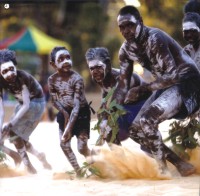|
Exhibition
 Dancing
to Life Dancing
to Life
The aborigines
across Australia have their own way of announcing their cultural
heritage. There are festivals to lay claim to cultures that
are as ancient as the land. The lives of the people who originally
owned the land were dynamically connected to the land; the
festivals too reveal an affinity with it. For the Aboriginal
people dance is the most dominant form to declaim their culture,
next to it is story-telling.
The cultural
diversity of the indigenous people bespeaks their heterogeneity.
Across the breadth and length of Australia social organisations
and spiritual beliefs are as diverse as the land itself.
 In
the main land and in Torres Strait Islands, there are festivals
to celebrate cultures that base itself on oral history and
dance ceremonies. A lot goes on to keep the tradition as well
as the spiritual beliefs alive. Garma Festival in Gulkula,
northern Australia, brings to light one of the oldest living
cultures in human history. Torres Strait Cultural Festival
in Torres Strait celebrates the bond of the people with the
sea. Stompen Ground, Broome, western Australia, is one of
the festivals that thrive on multiculturalism, and Larapuna,
Tasmania, where most of the aborigines have adopted to city
life, is mostly about entertainment. In
the main land and in Torres Strait Islands, there are festivals
to celebrate cultures that base itself on oral history and
dance ceremonies. A lot goes on to keep the tradition as well
as the spiritual beliefs alive. Garma Festival in Gulkula,
northern Australia, brings to light one of the oldest living
cultures in human history. Torres Strait Cultural Festival
in Torres Strait celebrates the bond of the people with the
sea. Stompen Ground, Broome, western Australia, is one of
the festivals that thrive on multiculturalism, and Larapuna,
Tasmania, where most of the aborigines have adopted to city
life, is mostly about entertainment.
 All
events are organised and managed by the aboriginal people.
There are events where the modern-day innovations are given
space. Most of them may look light-hearted, but the dances
associated with ceremonial practices are serious events. It
is through these events that the heritage is handed down from
one generation to the next. All
events are organised and managed by the aboriginal people.
There are events where the modern-day innovations are given
space. Most of them may look light-hearted, but the dances
associated with ceremonial practices are serious events. It
is through these events that the heritage is handed down from
one generation to the next.
"Kicking
up Dust" is an exhibition that encapsulates all this.
It has travelled to Dhaka courtesy of the Australian Department
of Foreign Affairs and Trade's Aboriginal and Torres Strait
Island Programme. Bengal Gallery of Fine Arts hosts the show
that seems like an eye-opener for most Dhakaites. It kicked
off on February and will last till March 18.
1.
Nanydjaka [na-ne-dja-ka] (Cape Arnhem) is an Indigenous Protected
Area on the edge of the Arafura Sea. The Garma site at Gulkula
([goo-koo-la] is situated on the escarpment overlooking this
tropical paradise.
2. 3. The opportunity of sharing the dance with their elders
and the thrill of getting the steps right in such illustrious
company shows in the self-confidence of these young boys.
4. Many different devices are used in performances. Here is
one of the more unusual ones with images of ancestral stories
carried on the shoulders of one of the dancers.
5. A member of the Thursday Island High School Dance Troupe
performing the Wave Dance from Boigu [Boy-goo] Island. The
group is a big draw card for the Festival and gets the crowd
pumped up.
6. The nationally popular Aboriginal performer Mary G entertains
the crowd with her particular style of ribald comedy, music
and insightful political comment.
Mustafa
Zaman
Copyright
(R) thedailystar.net 2005
| 